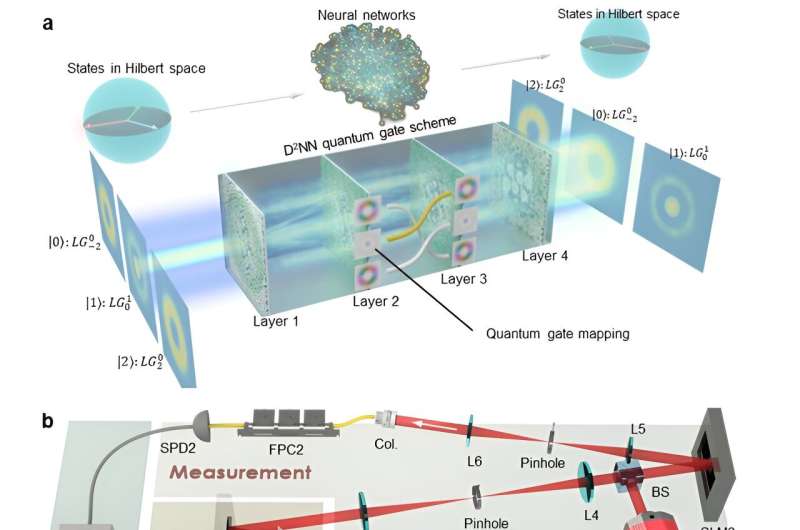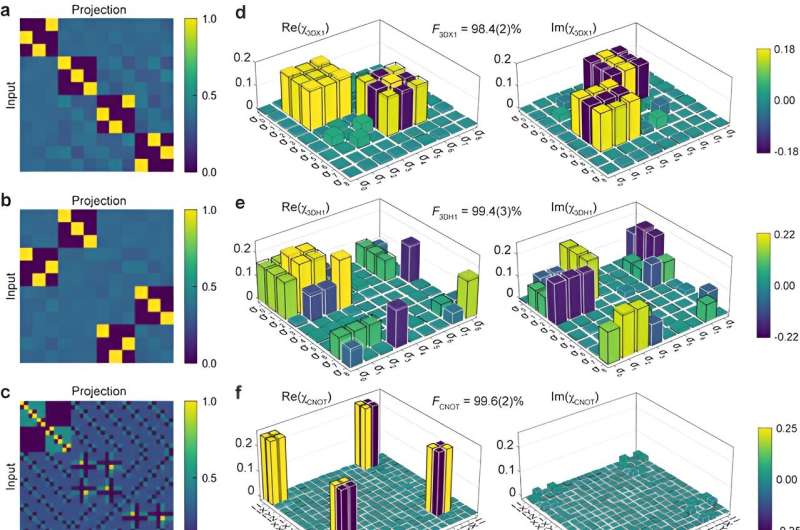This article has been reviewed according to Science X's editorial process and policies. Editors have highlighted the following attributes while ensuring the content's credibility:
fact-checked
peer-reviewed publication
proofread
High fidelity spatial mode quantum gates enabled by diffractive neural networks

Reliable quantum gates are the fundamental component of quantum information processing. However, achieving high-dimensional unitary transformations in a scalable and compact manner with ultrahigh fidelities remains a great challenge.
To address this issue, scientists in China showcase the use of deep diffractive neural networks (D2NNs) to construct a series of high-dimensional quantum gates, which are encoded by the spatial modes of photons. This work, published in Light: Science & Applications, offers a new paradigm for quantum gate design using deep learning.
Quantum computing holds the promise of transforming our information processing methodologies, and at its core, reliable quantum logic gates play an essential role in quantum information processing.
While various types of quantum gates have been demonstrated, photonic quantum gates are naturally compatible with quantum communications and have attracted considerable interest in the field of quantum information.
The intrinsic infinity of orthogonal bases in the spatial modes of photons offers an extensive coding alphabet, encouraging creativity in high-dimensional quantum information processing. However, achieving high-dimensional unitary transformations in an accurate, scalable and compact way with ultrahigh fidelities remains a significant challenge.
A team of scientists, led by Professor Jian Wang from Wuhan National Laboratory for Optoelectronics and School of Optical and Electronic Information, Huazhong University of Science and Technology, China, Optics Valley Laboratory, China, and co-workers have demonstrated the use of deep diffractive neural networks (D2NNs) to construct a series of high-dimensional quantum gates, which are encoded by the spatial modes of photons.
They implemented all three-dimensional X gates and Hadamard gates encoded by three Laguerre-Gaussian modes. The gates exhibit ultrahigh fidelities up to 99.4(3)%, as characterized through quantum process tomography. They also adopt a unique coding method to encode two bits of information, utilizing four orbital angular momentum (OAM) modes of a single photon.
With this method, they achieved the interchange of OAM's wave-front rotation direction (the sign of the mode) according to their mode orders. The reconstructed process matrix of this controlled-NOT gate has a fidelity of 99.6(2)%, and this high-fidelity gate enables reliable quantum computations.

They also demonstrated the applicability of this approach by successfully implementing the Deutsch algorithm, which involves performing the whole 2-qubit quantum circuit based on their experimental configuration. This demonstration validates the potential of performing complex operations or even quantum circuits.
The experimental demonstrations of all previously mentioned gates display the advantages of small footprint, great scalability and robustness to different mode bases. Moreover, based on the reconfigurable phase modulation device, this implementation is conducive to intelligent deployment, which shows extraordinary potential in performing automatic protocols to realize desired operations or to optimize the experimental performance.
To provide guidelines for experiments, they analyzed the relationship between quantum gate performance and various parameters, including loss and characteristics of the spatial light modulator. Additionally, they conducted a comparative analysis of the D2NN gate's performance to the traditional wave-front matching approach, leading to the conclusion that our approach significantly improves visibility at a small cost of energy loss.
More information: Qianke Wang et al, Ultrahigh-fidelity spatial mode quantum gates in high-dimensional space by diffractive deep neural networks, Light: Science & Applications (2024). DOI: 10.1038/s41377-023-01336-7
Journal information: Light: Science & Applications
Provided by TranSpread




















